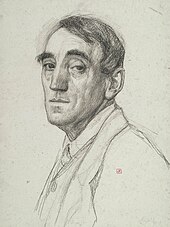Théo van Rysselberghe
Théo van Rysselberghe (born November 23, 1862 in Ghent ; † December 13, 1926 in Saint-Clair near Le Lavandou , France ) actually Théophile van Rysselberghe , was probably the most important Flemish painter of pointillism .
Life
His older brother is the Flemish architect Octave van Rysselberghe . Together with James Ensor , who was two years his senior , he trained as a painter at the Brussels Academy . One of his teachers there was Jean-François Portaels . His first works, which appeared in public at the Brussels Salon in 1881, show a strong influence from Édouard Manet and Edgar Degas . The following year he made an extensive trip to Spain and Morocco . During this trip he created a series of pictures with an exotic flair, which he presented to the public in 1883.
In 1883 he became one of the founding members of the Société des Vingt (Group of XX), a group of avant-garde artists who campaigned for artistic exchange between France and Belgium.
He was married to Maria van Rysselberghe (1866–1959), and their daughter Elisabeth (1890–1980) was born. Maria (also: Marie) became known as a close spiritual confidante of André Gide ; in the Paris and Colpach literary circles she was known as "the little lady" (la petite dame).
On a trip to Paris he got to know Georges Seurat and his pointillist painting technique. Seurat's very well-known painting Summer Sunday on La Grande Jatte ( French: Le Dimanche d'été à la Grande Jatte ) fascinated him. He made this painting technique his own and remained loyal to it from 1890 to 1910. In addition to painting, he also practiced sculpture and graphic arts. Furthermore, his poster designs from this time z. B. for the Compagnie Internationale des Wagons-Lits still appreciated today (2011).
At Easter 1893 he visited his friend Henry van de Velde together with his wife and Émile Verhaeren , Alfred William Finch and Maria Sèthe who was a student of his . A year later, Maria married Sèthe and van de Velde.
In 1897 he moved to Paris. After the death of his friend and role model Georges Seurat, he gradually turned away from pointillism. In 1910 he moved to the French Mediterranean coast. In his later years he painted a number of brightly colored female nudes that exuded a lively, happy mood.
Exhibitions
- 1993: Théo van Rysselberghe - Neo-Impressionist , Gent, Belgium
- 2006: Théo van Rysselberghe , Palais des Beaux-Arts , Brussels, Belgium and Gemeentemuseum , The Hague, Netherlands
literature
- Ronald Feltkamp: Théo Van Rysselberghe - 1862–1926. Éditions de l'Amateur, Paris 2003, ISBN 2-85917-389-7 (French, biography and catalog of works).
Web links
- Biography of Théo Van Rysselberghe
Individual evidence
- ↑ Rysselberghe, Théophile van . In: Hans Vollmer (Hrsg.): General lexicon of fine artists from antiquity to the present . Founded by Ulrich Thieme and Felix Becker . tape 29 : Rosa – Scheffauer . EA Seemann, Leipzig 1935, p. 275 .
- ↑ Gladly at its finest: Souvenirs from the golden age of the railways in Paris. In: Frankfurter Allgemeine Zeitung . September 24, 2011, p. 41.
- ↑ Henry van de Velde: Maria Sèthe and Henry van de Velde, pp. 76-78. Retrieved April 18, 2020 .
| personal data | |
|---|---|
| SURNAME | Rysselberghe, Théo van |
| ALTERNATIVE NAMES | Rysselberghe, Théophile van |
| BRIEF DESCRIPTION | Flemish pointillist painter |
| DATE OF BIRTH | November 23, 1862 |
| PLACE OF BIRTH | Ghent |
| DATE OF DEATH | December 13, 1926 |
| Place of death | Saint-Clair, Le Lavandou , France |


